

Titled. Although the world’s water supplies are expected to remain sufficient for a global population of nine billion in 2050, continuing overconsumption and the impact of climate change will diminish their availability in many of the planet’s neediest regions, according to a new United Nations Food and Agriculture Organization (FAO) report.
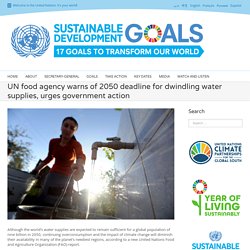
The report – entitled Towards a water and food secure future and launched today at the World Water Forum in concomitance with the World Water Council – urges government policies and public and private investment to ensure that crops, livestock and fish are sustainably produced in ways also aimed at safeguarding water resources. Without such measures, the report warns, efforts to reduce poverty, increase incomes and ensure food security in many developing nations will become increasingly difficult. Improvements to the overall outlook, however, are possible, says the FAO. via UN News Centre. 201205 africa scorecard. 2 Africa Development Aid at a Glance 2016. The Science Behind the P&G Packet Technology The P&G water purification technology in a powder, is an amazing innovation that quickly turns 10 liters of dirty, potentially deadly water into clean and drinkable water.
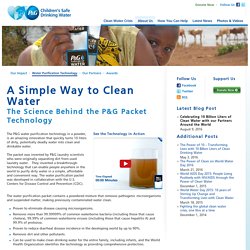
The packet was invented by P&G laundry scientists who were originally separating dirt from used laundry water. They invented a breakthrough technology that can enable people anywhere in the world to purify dirty water in a simple, affordable and convenient way. The water purification packet was developed in collaboration with the U.S. Centers for Disease Control and Prevention (CDC). Water and Sanitation - United Nations Sustainable Development. Water and SanitationFlorencia Soto Nino2016-08-17T17:54:39+00:00 Share this story, choose your platform!
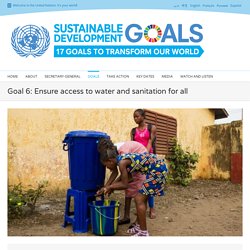
Clean, accessible water for all is an essential part of the world we want to live in. There is sufficient fresh water on the planet to achieve this. Home. World Vision Australia. Our approach to water, sanitation and hygiene Create a clean start to set children up for life The first 1,000 days of life are critical to children’s health, and water, sanitation and hygiene is a vital part of this.
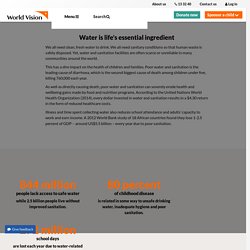
We integrate our work with maternal, newborn and child health, nutrition and early childhood development – far more effective than addressing any of these areas in isolation. Provide flow-on benefits for disadvantaged groups. 48 Million Indian Children Suffer From Stunted Growth. India has the highest number of stunted children in the world, according to a new report.

By Roshni Kapur for The Diplomat August 26, 2016 A new report, titled Caught Short, found that around 48 million children under the age of five in India suffer from stunted growth — two out of every five Indian children. India had by far the world’s highest number; Nigeria and Pakistan were ranked second and third with 10.3 and 9.8 million children suffering from stunted growth, respectively. The report was commissioned by the international development charity WaterAid. Stunting, or chronic malnutrition, is a type of growth failure that occurs in the first two years of a child’s life and is largely irreversible.
Theconversation. Globally every year nearly a quarter of a million children under the age of five die from diarrhoea caused by the rotavirus.
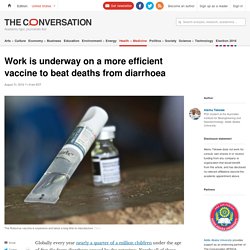
Nearly all of these deaths are in the developing world. The rotavirus is a bug that results in acute gastroenteritis, diarrhoea and then severe dehydration. It can also cause fever and vomiting. Without proper medical attention it can be fatal. Seven of the 10 countries that account for most rotavirus deaths are in Africa. There are no drugs available to treat rotavirus. Currently an international organisation, the Gavi vaccine alliance, finances developing countries to procure rotavirus vaccines.
Theconversation. Around 2.5 billion people in developing countries do not have access to basic sanitation.
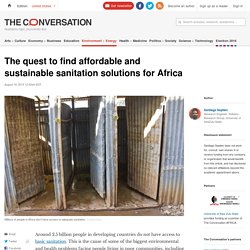
This is the cause of some of the biggest environmental and health problems facing people living in poor communities, including water pollution and the transmission of diseases and infections. But installing and operating sewage and wastewater treatment plants is expensive, making them unaffordable. On top of that, conventional wastewater treatment is not an environmentally friendly process because so much energy is used. There are also disposal complications. Global warming and climate change. Pollution leading to global warming, climate change and the acidification of our oceans affects every aspect of conservation.
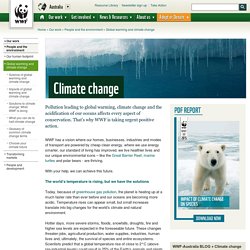
That’s why WWF is taking urgent positive action. WWF has a vision where our homes, businesses, industries and modes of transport are powered by cheap clean energy, where we use energy smarter, our standard of living has improved, we live healthier lives and our unique environmental icons – like the Great Barrier Reef, marine turtles and polar bears - are thriving. With your help, we can achieve this future.
The world’s temperature is rising, but we have the solutions Today, because of greenhouse gas pollution, the planet is heating up at a much faster rate than ever before and our oceans are becoming more acidic. Michael Mann And The Iconic 'hockey Stick' Graphic At The Center Of The Climate Debate. The "Hockey Stick" graph, a simple plot representing temperature over time, led to the center of the larger debate on climate change, and skewed the trajectory of at least one researcher, according to Michael Mann, Distinguished Professor of Meteorology at Penn State.
"The "Hockey Stick" graph became a central icon in the climate wars," Mann told attendees today last week at the annual meeting of the American Association for the Advancement of Science. "The graph took on a life of its own. " Mann and his coauthors, Raymond S. Theconversation. Nations are gathering in New York this week to discuss the UN Sustainable Development Goals (SDGs), which aim to improve health, wealth and well-being for countries both rich and poor.

As a developed nation, it might be assumed that Australia will easily meet these new goals at home – including goal number 6, to ensure “availability and sustainable management of water and sanitation for all”. But the unpalatable truth is that many Australians still lack access to clean water and effective sanitation. The World Bank’s Development Indicators list Australia as having 100% access to clean water and effective sanitation. But a discussion paper we released last week with our colleagues outlines how some remote Aboriginal communities struggle to meet Australian water standards.
Theconversation. UNICEF urges swift action to close water and sanitation gaps. Some 180,000 children under the age of five die every year – roughly 500 a day – in sub–Saharan Africa due to diarrhoeal diseases linked to inadequate water, sanitation and hygiene, the United Nations Children”s Fund (UNICEF) warned today ahead of a conference in the region on boosting financing for the sector. Aiming to help bring universal access to water and sanitation to West and Central Africa, UNICEF has convened, in cooperation with the Government of Senegal and the African Minister’s Council on Water, the first West and Central Africa Innovative Financing for Water Sanitation & Hygiene, which will be held in the Senegalese capital from today through Thursday, 17 December.
According to UNICEF, nearly half of the global population without access to improved drinking water lives in sub – Saharan Africa currently and some 700 million people in the region lack access to improved sanitation. Access to sanitation is even more challenging.   Via UN News Centre. Sanitation becomes separate UN human right. With more than 2.5 billion people worldwide, one third of the total population, living without access to proper toilets, the United Nations General Assembly has recognised sanitation as a separate human right in a bid to curb a major source of deadly infections.
“It gives people a clearer perception of the right, strengthening their capacity to claim this right when the State fails to provide the services or when they are unsafe, unaffordable, inaccessible or with inadequate privacy,” UN Special Rapporteur on the human rights of safe drinking water and sanitation Léo Heller said.
Desalination. The Victorian Desalination Plant is capable of producing water to the quality and quantity required, and can deliver up to 150 billion litres of high quality water to Melbourne’s water network if required by removing salts and minerals from seawater by passing it through reverse osmosis membranes. As a rainfall-independent source of water the plant supplements Victoria's existing water supply system and is a useful resource in times of natural disasters, like drought or bushfires. The Department of Environment, Land, Water and Planning (DELWP) manage the plant’s contract with AquaSure on behalf of the state. Where we work - Ethiopia. Global Majority e Journal 3 2 Hendrix. Agua potable, saneamiento e higiene en Etiopía. Drinking water, sanitation and hygiene in Ethiopia. In the Oromiya and Southern Nations, Nationalities and People’s regions of Ethiopia, there is limited access to drinking water and basic sanitation.
Contaminated water leads to death and disease, and harvests are entirely dependent on rainfall, which is why they are insufficient. Ethiopia Water Crisis: Clean Water Scarcity In Ethiopia. In rural Ethiopia, women and children walk up to six hours to collect water. Most people collect water from shallow, unprotected ponds which they share with animals. Other people collect water from shallow wells. Both of these sources are subject to contamination as rain water washes waste from surrounding areas into the source. The jugs women use to carry water back to the village weigh up to 40 pounds! Often, young children are left at home while their mother and older siblings collect water and their fathers work.
In the last 20 years, Ethiopia has experienced recurring droughts followed by food shortages and famines. In times of drought, there is often not enough water available for people to bathe regularly. Titled. Water In Crisis - Spotlight Ethiopia. Rebecca Shore (Guest Writer) CSDW News & Blog. Check out the most recent blog entries from P&G Children’s Safe Drinking Water Program (CSDW) and share your thoughts. Or, browse our archive content for a look back at the global efforts as told by Dr. Greg Allgood, Founder of the CSDW Program. Contributed by: Jason Priestley. The Clean Drinking Water Crisis. Share Clean Water. The lazy person's guide to saving the world - United Nations Sustainable Development.
End extreme poverty. Fight inequality and injustice. Fix climate change. Whoa. The Global Goals are important, world-changing objectives that will require cooperation among governments, international organizations and world leaders. It seems impossible that the average person can make an impact. No! We’ve made it easy for you and compiled just a few of the many things you can do to make an impact. Things you can do from your couchSave electricity by plugging appliances into a power strip and turning them off completely when not in use, including your computer.Stop paper bank statements and pay your bills online or via mobile. Things you can do at homeAir dry.
Things you can do outside your house Shop local. These are only a few of the things you can do. UN - Open Defecation. Water & Sanitation. UN - Open Defecation. International Decade for Action 'Water for Life' 2005-2015. Water and ocean governance. Water Security. World Water Assessment Programme. Access to clean water. Zimbabwean child collecting water from a well. Poor sanitation threatens public health. 2012. Untitled. Untitled. Water catchments. Protected catchments.